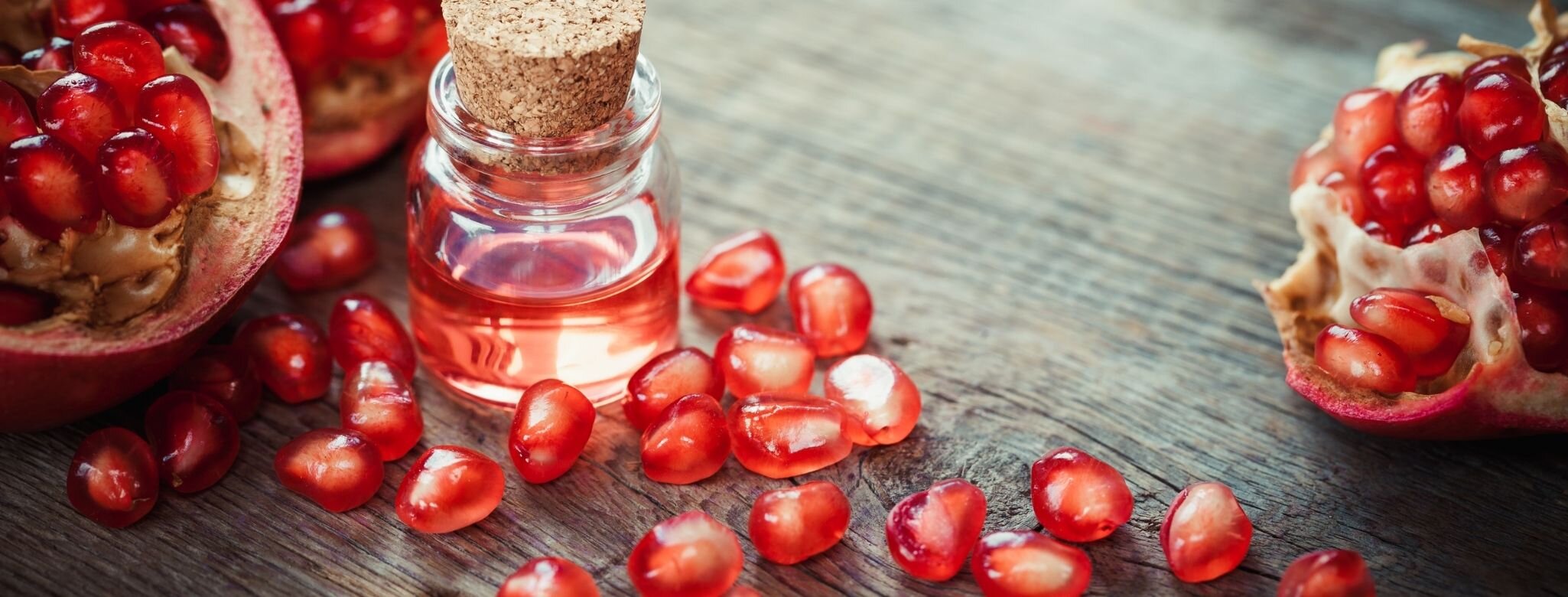Pomegranate Seed Oil
Appearance/form: Golden Yellow/Clear Oil
Saponification value: 185-200
SAP Value NaOH: 0.135
SAP Value KOH: 0.190
INCI name (PCPC) : Punica granatum
CAS No: 84961-57-9
Iodine Value: 152-195
Family: Lythraceae
Introduction
Over the last few years, pomegranates have become popular because of their various health benefits. The fruit plays a major role in the Mediterranean diet, where it is used extensively in cooking, baking and winemaking. The plant is cultivated in the Middle East, North Africa, South America, India, and Southeast Asia (1). The pomegranate was known as the "apple of Grenada" with roots in its Latin name - pōmum, which means "an apple," and "grānātum", which means "seeded" (2). In Hebrew and Arabic, the word for pomegranate means “Fruit of Paradise" (3). The pomegranate fruit and seeds are known for their beneficial effects on skin health and overall physical health.
Physical and Chemical Characteristics
The fruits are borne by short shrubs, with spiny branches, oblong leaves, and bright red flowers. The fruit has a thick outer husk and a white inner lining or mesocarp where the seeds are attached. The number of seeds in a single pomegranate can vary from 200 to 1400. The edible fruits are berries, where their characteristic bright red juice is obtained by compressing the seeds. The juice is rich in polyphenols and anthocyanins, which are responsible for its rich pigment and ellagitannins, which gives the juice a sweet and slightly sour taste. The seeds when eaten are a rich source of dietary fiber. Seed oils are extracted by cold compress or chemical solvents and are usually included as preservatives and functional ingredients in the food, pharmaceutical, and cosmetic industries (5).
Pomegranate Seed Oil Fatty Acid Profile
Health Benefits of Internal Use
Pomegranate seed oil is rich in polyphenols, carotenoids, vitamin C and unsaturated fatty acids ,which are strong antioxidants, immunity boosters and are known to fight inflammation. Research has also shown that PSO can reduce high cholesterol and lipid levels (7). It is also known to decrease the weight of adipose tissues or fat cells and helps combat obesity. Due to its rich punicic acid content, it is being studied for its beneficial effects in controlling blood sugar levels by managing insulin resistance (8). A study has even demonstrated its toxic effects on oesophageal cancer cells in a laboratory (9).
Skin and Hair Care Benefits
Antioxidants and vitamin C found in pomegranate seed oil help to reduce cellular damage in the skin. With enhanced cell regeneration, its effects are being studied to reduce age spots or wrinkles. In addition, it is believed to improve skin elasticity by enhancing hydration in the layers of the dermis and is also used as a skin whitening agent.
Research also shows that PSO can absorb UVA and UVB rays from the sun, reducing the effects of harmful ultraviolet radiation on the skin, including skin cancer. It is an active component of sunscreens and body lotions (10).
The bioactive compounds in seed oil like ellagic acid and punicic acid are integrated into skin health products. They inhibit fungal and bacterial growth on the skin and hair, reducing the chances of acne breakouts or dandruff. PSO increases collagen production and can be used to speed up the healing of burns and wounds on the skin (11).
Conclusion
With its anti-inflammatory and antioxidant effects, pomegranate seed oil is used in many skincare and cosmetic formulations.
References
1.Morton, J. F. (1987).""Pomegranate, Punica granatum "". Fruits of Warm Climates. Purdue New Crops Profile. pp. 352–5
2.Ref: https://thelecrinvalley.org/tag/pomegranate/
3.Stover, Ed, & Mercure, E. W. (2007). The Pomegranate: A New Look at the Fruit of Paradise, HortScience horts, 42(5), 1088-1092. Retrieved Sep 11, 2021, from https://journals.ashs.org/hortsci/view/journals/hortsci/42/5/article-p1088.xml
4.Fernandes L, Pereira JA, Lopéz-Cortés I, Salazar DM, Ramalhosa EC. Physicochemical Changes and Antioxidant Activity of Juice, Skin, Pellicle and Seed of Pomegranate (cv. Mollar de Elche) at Different Stages of Ripening. Food Technol Biotechnol. 2015;53(4):397-406. doi:10.17113/ftb.53.04.15.3884
5. Siano F, Straccia MC, Paolucci M, Fasulo G, Boscaino F, Volpe MG. Physico-chemical properties and fatty acid composition of pomegranate, cherry and pumpkin seed oils. J Sci Food Agric. 2016;96(5):1730-1735. doi:10.1002/jsfa.7279
6.Schubert SY, Lansky EP, Neeman I. Antioxidant and eicosanoid enzyme inhibition properties of pomegranate seed oil and fermented juice flavonoids. J Ethnopharmacol. 1999;66(1):11-17.
7.Mirmiran, P.; Fazeli, M. R.; Asghari, G.; Shafiee, A.; Azizi, F. Effect of Pomegranate Seed Oil on Hyperlipidaemic Subjects: A -Controlled Clinical Trial. J. Nutri. 2010, 104, 402–406. DOI: 10.1017/S0007114510000504.
8.Aruna P, Venkataramanamma D, Singh AK, Singh R. Health Benefits of Punicic Acid: A Review. Compr Rev Food Sci Food Saf. 2016;15:16–27.
9. Zare M, Shaverdi H, Ebrahimi Vosta Kalaee S. Anti-cancer Effects of Pomegranate Seed Oil on Esophageal Cancer Cell Line (KYSE-30), Gene Cell Tissue. 2021 ; 8(1):e108995.
10.Zarfeshany A, Asgary S, Javanmard SH. Potent health effects of pomegranate. Adv Biomed Res. 2014;3:100. Published 2014 Mar 25. doi:10.4103/2277-9175.129371
11. Ko, K.; Dadmohammadi, Y.; Abbaspourrad, A. Nutritional and Bioactive Components of Pomegranate Waste Used in Food and Cosmetic Applications: A Review. Foods 2021, 10, 657.

